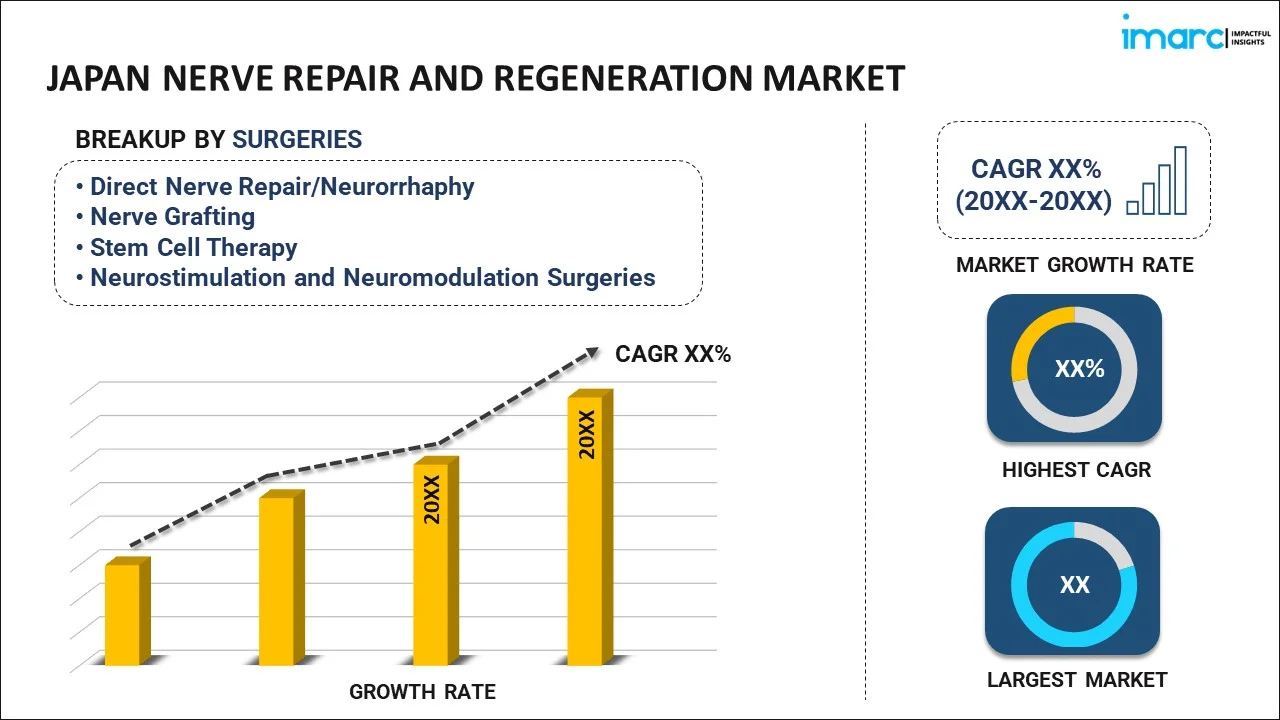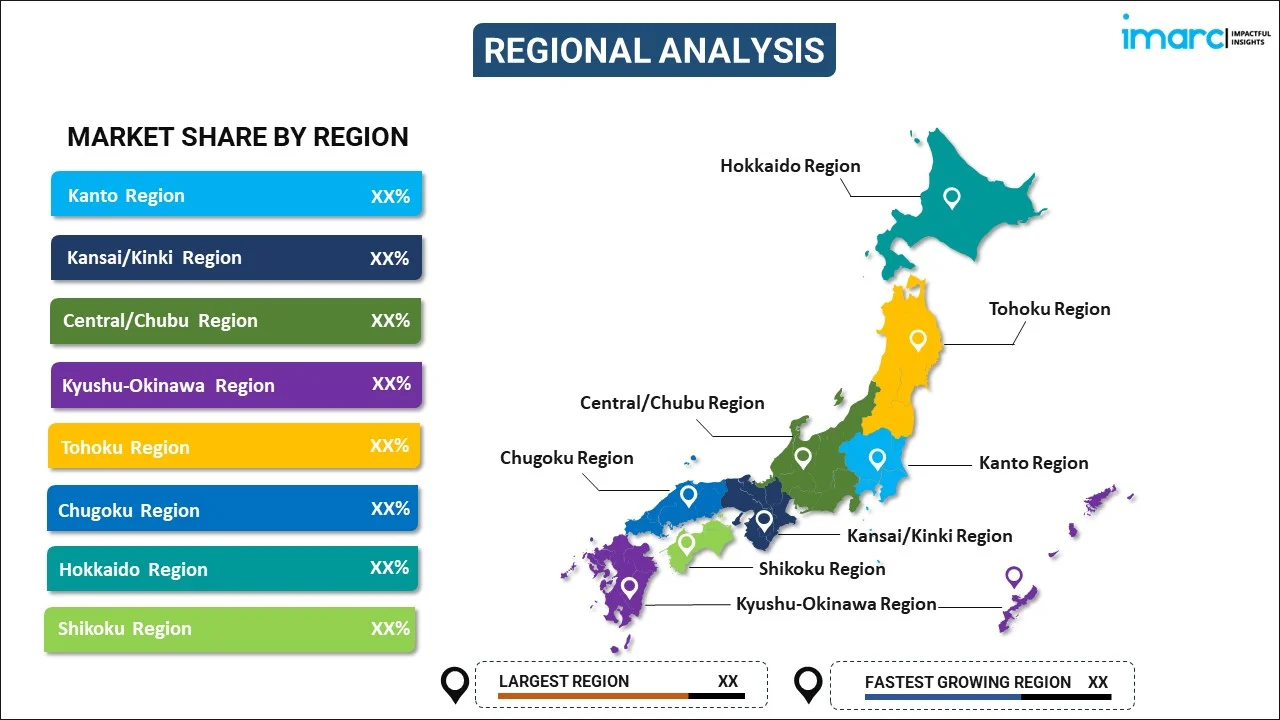
Japan Nerve Repair and Regeneration Market Report by Surgery (Direct Nerve Repair/Neurorrhaphy, Nerve Grafting, Stem Cell Therapy, Neurostimulation and Neuromodulation Surgeries), Product (Biomaterial, Neurostimulation and Neuromodulation Devices), End User (Hospitals and Clinics, Ambulatory Surgical Centers), and Region 2025-2033
Market Overview:
Japan nerve repair and regeneration market size reached USD 322.3 Million in 2024. Looking forward, IMARC Group expects the market to reach USD 1,055.6 Million by 2033, exhibiting a growth rate (CAGR) of 14.1% during 2025-2033. The increasing advances in genetics and personalized medicine, which are enabling the tailoring of treatments to individual patients, thereby potentially improving the efficacy of nerve repair and regeneration interventions, are driving the market.
|
Report Attribute
|
Key Statistics
|
|---|---|
|
Base Year
|
2024 |
|
Forecast Years
|
2025-2033 |
|
Historical Years
|
2019-2024
|
| Market Size in 2024 | USD 322.3 Million |
| Market Forecast in 2033 | USD 1,055.6 Million |
| Market Growth Rate (2025-2033) | 14.1% |
Nerve repair and regeneration refers to the processes by which damaged or injured nerves in the human body are restored to their functional state. This intricate biological mechanism involves a series of complex steps. When a nerve is injured, it initiates a healing response, primarily driven by specialized cells called Schwann cells in the peripheral nervous system. These cells play a crucial role in facilitating nerve regeneration. The process typically begins with the removal of damaged tissue and the formation of a growth cone at the tip of the regenerating nerve. This growth cone extends toward its target, guided by chemical cues and a pathway known as the endoneurial tube. Nerve fibers gradually regrow and can reestablish connections with their target cells. Factors that influence nerve repair and regeneration include the extent and location of the injury, the individual's overall health, and the type of nerve involved. Complete recovery may not always be possible, especially in cases of severe damage. Researchers are continually exploring methods to enhance nerve repair, such as nerve grafts, growth-promoting factors, and stem cell therapies, to improve outcomes for individuals with nerve injuries or disorders.
Japan Nerve Repair and Regeneration Market Trends:
The nerve repair and regeneration market in Japan is driven by several key factors that are interrelated. Firstly, the rising incidence of neurological disorders and injuries, such as spinal cord injuries and peripheral nerve damage, is a primary driver. As the regional population continues to age, the prevalence of conditions like Parkinson's disease and Alzheimer's disease is also increasing, necessitating innovative solutions for nerve repair. Furthermore, advancements in regenerative medicine and biotechnology have paved the way for cutting-edge treatments, creating a favorable environment for market growth. Breakthroughs in stem cell therapy, tissue engineering, and gene editing techniques have unlocked novel avenues for nerve repair, fostering substantial market expansion. In addition to this, growing investments in healthcare infrastructure and R&D activities have propelled the nerve repair and regeneration market forward. Lastly, the increasing awareness and demand for minimally invasive surgical procedures, coupled with patient preference for improved outcomes and quality of life, is expected to drive the nerve repair and regeneration market in Japan during the forecast period.
Japan Nerve Repair and Regeneration Market Segmentation:
IMARC Group provides an analysis of the key trends in each segment of the market, along with forecasts at the country level for 2025-2033. Our report has categorized the market based on surgery, product, and end user.
Surgery Insights:

- Direct Nerve Repair/Neurorrhaphy
- Nerve Grafting
- Stem Cell Therapy
- Neurostimulation and Neuromodulation Surgeries
The report has provided a detailed breakup and analysis of the market based on the surgery. This includes direct nerve repair/neurorrhaphy, nerve grafting, stem cell therapy, and neurostimulation and neuromodulation surgeries.
Product Insights:
- Biomaterial
- Neurostimulation and Neuromodulation Devices
- Spinal Cord Stimulation Devices
- Deep Brain Stimulation Devices
- Sacral Nerve Stimulation Devices
- Vagus Nerve Stimulation Devices
- Gastric Electric Stimulation Devices
A detailed breakup and analysis of the market based on the product have also been provided in the report. This includes biomaterial and neurostimulation and neuromodulation devices (spinal cord stimulation devices, deep brain stimulation devices, sacral nerve stimulation devices, vagus nerve stimulation devices, and gastric electric stimulation devices).
End User Insights:
- Hospitals and Clinics
- Ambulatory Surgical Centers
The report has provided a detailed breakup and analysis of the market based on the end user. This includes hospitals and clinics and ambulatory surgical centers.
Regional Insights:

- Kanto Region
- Kansai/Kinki Region
- Central/ Chubu Region
- Kyushu-Okinawa Region
- Tohoku Region
- Chugoku Region
- Hokkaido Region
- Shikoku Region
The report has also provided a comprehensive analysis of all the major regional markets, which include Kanto Region, Kansai/Kinki Region, Central/ Chubu Region, Kyushu-Okinawa Region, Tohoku Region, Chugoku Region, Hokkaido Region, and Shikoku Region.
Competitive Landscape:
The market research report has also provided a comprehensive analysis of the competitive landscape in the market. Competitive analysis such as market structure, key player positioning, top winning strategies, competitive dashboard, and company evaluation quadrant has been covered in the report. Also, detailed profiles of all major companies have been provided.
Japan Nerve Repair and Regeneration Market Report Coverage:
| Report Features | Details |
|---|---|
| Base Year of the Analysis | 2024 |
| Historical Period | 2019-2024 |
| Forecast Period | 2025-2033 |
| Units | Million USD |
| Scope of the Report | Exploration of Historical and Forecast Trends, Industry Catalysts and Challenges, Segment-Wise Historical and Predictive Market Assessment:
|
| Surgeries Covered | Direct Nerve Repair/Neurorrhaphy, Nerve Grafting, Stem Cell Therapy, Neurostimulation and Neuromodulation Surgeries |
| Products Covered |
|
| End Users Covered | Hospitals and Clinics, Ambulatory Surgical Centers |
| Regions Covered | Kanto Region, Kansai/Kinki Region, Central/ Chubu Region, Kyushu-Okinawa Region, Tohoku Region, Chugoku Region, Hokkaido Region, Shikoku Region |
| Customization Scope | 10% Free Customization |
| Post-Sale Analyst Support | 10-12 Weeks |
| Delivery Format | PDF and Excel through Email (We can also provide the editable version of the report in PPT/Word format on special request) |
Key Questions Answered in This Report:
- How has the Japan nerve repair and regeneration market performed so far and how will it perform in the coming years?
- What has been the impact of COVID-19 on the Japan nerve repair and regeneration market?
- What is the breakup of the Japan nerve repair and regeneration market on the basis of surgery?
- What is the breakup of the Japan nerve repair and regeneration market on the basis of product?
- What is the breakup of the Japan nerve repair and regeneration market on the basis of end user?
- What are the various stages in the value chain of the Japan nerve repair and regeneration market?
- What are the key driving factors and challenges in the Japan nerve repair and regeneration?
- What is the structure of the Japan nerve repair and regeneration market and who are the key players?
- What is the degree of competition in the Japan nerve repair and regeneration market?
Key Benefits for Stakeholders:
- IMARC’s industry report offers a comprehensive quantitative analysis of various market segments, historical and current market trends, market forecasts, and dynamics of the Japan nerve repair and regeneration market from 2019-2033.
- The research report provides the latest information on the market drivers, challenges, and opportunities in the Japan nerve repair and regeneration market.
- Porter's five forces analysis assist stakeholders in assessing the impact of new entrants, competitive rivalry, supplier power, buyer power, and the threat of substitution. It helps stakeholders to analyze the level of competition within the Japan nerve repair and regeneration industry and its attractiveness.
- Competitive landscape allows stakeholders to understand their competitive environment and provides an insight into the current positions of key players in the market.
Need more help?
- Speak to our experienced analysts for insights on the current market scenarios.
- Include additional segments and countries to customize the report as per your requirement.
- Gain an unparalleled competitive advantage in your domain by understanding how to utilize the report and positively impacting your operations and revenue.
- For further assistance, please connect with our analysts.
 Request Customization
Request Customization
 Speak to an Analyst
Speak to an Analyst
 Request Brochure
Request Brochure
 Inquire Before Buying
Inquire Before Buying




.webp)




.webp)












